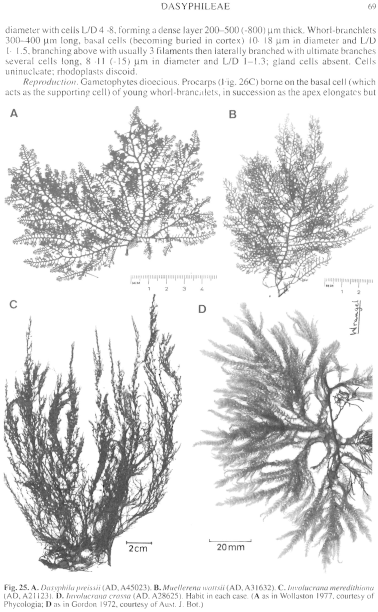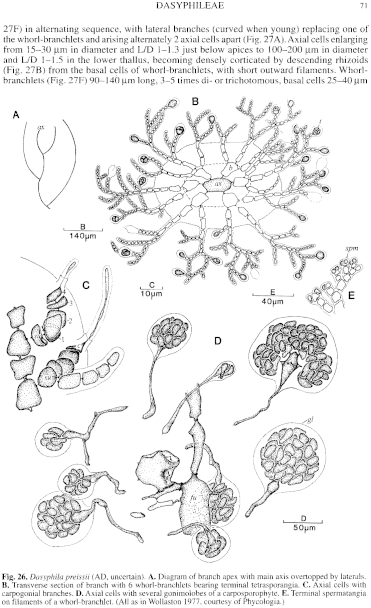|
|
|
|
|
|||||||||||
|
Electronic Flora of South Australia Species Fact Sheet
Phylum Rhodophyta – Order Ceramiales – Family Ceramiaceae – Tribe Dasyphileae
Selected citations: J. Agardh 1851: 104; 1876: 88. De Toni 1903: 1387. Harvey 1855a: 558; 1859a: pl. 66; 1863, synop.: xlix. Huisman 1997: 197. Kijtzing 1849: 673; 1862: 20, p1. 65a, b. Lucas 1909: 50; 1929b: 52. Lucas & Perrin 1947: 342, fig. 169. May 1965: 376. Mazza 1911: No. 395. Schmitz & Hauptfleisch 1897: 495. Silva et al. 1996: 407. Wollaston 1977a: 443, figs 1–16.
Thallus (Fig. 25A) mid to dark red-brown, 5–20 cm high, consistently distichously branched for 4–5 orders with alternate lateral branches (Fig. 26A) throughout, axes and branches terete or very slightly compressed, densely corticated with rhizoids from close to apices with the whorl-branchlets largely outside the cortication. Holdfast discoid, rhizoidal, 1–3 mm across; epilithic or epiphytic on larger algae. Structure. Apical cells dividing transversely or slightly obliquely, subapical cells cutting off 6 whorl-branchlets (Fig. 26B) in a largely alternating sequence, with lateral branches arising from the first or fourth formed whorl-branchlet (2–) 4 (–6) axial cells apart. Axial cells enlarging from 6–10 µm in diameter and L/D 1–1.2 just below the apices to 300–400 µm in diameter and L/D 1.5–4 in lower parts, becoming corticated by descending rhizoidal filaments from the basal cell of whorl-branchlets, rhizoids 5–8 µm in diameter with cells L/D 4–8, forming a dense layer 200–500 (–800) µm thick. Whorl-branchlets 300–400 µm long, basal cells (becoming buried in cortex) 10–18 µm in diameter and L/D 1–1.5, branching above with usually 3 filaments then laterally branched with ultimate branches several cells long, 8–11 (–15) µm in diameter and L/D 1–1.3; gland cells absent. Cells uninucleate; rhodoplasts discoid.
Reproduction: Gametophytes dioecious. Procarps (Fig. 26C) borne on the basal cell (which acts as the supporting cell) of young whorl-branchlets, in succession as the apex elongates but only one maturing at each tip. Carpogonial branches 4-celled, with an auxiliary cell cut off from the supporting cell and dividing transversely to form a lower cell which pit-connects with the axial cell and an upper gonimoblast cell which develops elongate stalk cells (Fig. 26D) each bearing a rounded group 90–200 µm across of carposporangia 10–15 µm in diameter, situated at branch apices and covered by adjacent elongate whorl-branchlets but not a special involucre. Spermatangia (Fig. 26E) are borne on short branches on outer cells of whorl-branchlets, ovoid, 3–5 µm in diameter.
Tetrasporangia (Fig. 26B) occur terminally on end cells of whorl-branchlets, subspherical, 25–35 µm in diameter, tetrahedrally divided.
Type from W. Aust. (Preiss); lectotype in BM (not located in MEL).
Selected specimens: Port Denison, W. Aust., drift (Gordon, 8.xi.1968; AD, A33206). Cliff Head, W. Aust., drift (Womersley, 18.ix.1979; AD, A51243). Head of Great Australian Bight, S. Aust., drift (Womersley, 4.ii.1954; AD, A19219). Pearson I., S. Aust., 48 m deep (Shepherd, 9.i.1969; AD, A33716). Elliston, S. Aust., 1–2 m deep in bay (Shepherd, 14.v.1971; AD, A38619). Avoid Bay, S. Aust., drift (Womersley, 30.xi.1975; AD, A46841). Port Elliot, S. Aust., drift (Womersley, 21.vi.1964; AD, A28016), (Kraft, 13.v.1971; AD, A38587 and 7.vii.1973; AD, A43729) and (Culic, 13.iv.1974; AD, A45023). Middle R., Kangaroo I., S. Aust., drift (Womersley, 8.i.1946; AD, A3387). Cape du Couedic, Kangaroo I., S. Aust., shaded pools (Womersley, 16.i.1965; AD, A28970). Seal Bay, Kangaroo I., S. Aust., drift (Womersley, 21.i.1965; AD, A28688). D'Estrees Bay, Kangaroo I., S. Aust., on fucoid algae, drift (Kraft, 12.iv.1973; AD, A43713). Kingston, S. Aust., drift (Womersley, 9.viii.1961; AD, A24874). Cape Thomas, Guichen Bay, S. Aust., drift (Womersley, 24.viii.1960; AD, A24384). Queenscliff, Vic., drift (Wollaston, 17.viii.1956; AD, A20562). Waratah Bay, Vic., drift (Sinkora A2676, 24.xi.1979; AD, A61068).
Distribution: Geraldton and Houtman Abrolhos, W. Aust., to Wilsons Prom., Vic., and N Tasmania.
References:
AGARDH, J.G. (1851). Species Genera et Ordines Algarum. Vol. 2, Part 1, I-XII, 1–336 + index. (Gleerup: Lund.)
AGARDH, J.G. (1876). Species Genera et Ordines Algarum. Vol. 3, Part 1- Epicrisis systematic Floridearum, pp. i-vii, 1–724. (Weigel: Leipzig.)
DE TONI, G.B. (1903). Sylloge Algarum omnium hucusque Cognitarum. Vol. 4. Florideae. Sect. 3, pp. 775–1521 + 1523–1525. (Padua.)
HARVEY, W.H. (1855a). Some account of the marine botany of the colony of Western Australia. Trans. R. Jr. Acad. 22, 525–566.
HARVEY, W.H. (1859a). Phycologia Australica. Vol. 2, Plates 61–120. (Reeve: London.)
HARVEY, W.H. (1863). Phycologia Australica. Vol. 5, Plates 241–300, synop., pp. i-lxxiii. (Reeve: London.)
HUISMAN, J.M. (1997). Marine Benthic Algae of the Houtman Abrolhos Islands, Western Australia. In Wells, F.E. (Ed.) The Marine Flora and Fauna of the Houtman Abrolhos Islands, Western Australia, pp. 177–237. (W. Aust. Museum: Perth.)
LUCAS, A.H.S. & PERRIN, F. (1947). The Seaweeds of South Australia. Part 2. The Red Seaweeds. (Govt Printer: Adelaide.)
LUCAS, A.H.S. (1909). Revised list of the Fucoideae and Florideae of Australia. Proc. Linn. Soc. N.S.W. 34, 9–60.
LUCAS, A.H.S. (1929b). A census of the marine algae of South Australia. Trans. R. Soc. S. Aust. 53, 45–53.
MAY, V. (1965). A census and key to the species of Rhodophyceae (red algae) recorded from Australia. Contr. N.S.W. natn. Herb. 3, 349–429.
MAZZA, A. (1911). Saggio di Algologia Oceanica. Nuova Notarisia 22, Nos. 369–393.
SCHMITZ, F. & HAUPTFLEISCH, P. (1897). Ceramiaceae. In Engler, A. & Prantl, K., Die natarlichen Pflanzenfamilien, Vol. 1, Part 2, pp. 481–504. (Leipzig.)
SILVA, P.C., BASSON, P.W. & MOE, R.L. (1996). Catalogue of the Benthic Marine Algae of the Indian Ocean. (University of California Press: Berkeley, Los Angeles & London.)
SONDER, O.G. (1845). Nova Algarum genera et species, quas in itinere ad oras occidentales Novae Hollandiae, collegit L. Preiss, Ph.Dr. Bot. Zeit. 3, 49–57.
SONDER, O.W. (1848). Algae. In Lehmann, C., Plantae Preissianae. Vol. 2, pp. 161–195. (Hamburg.)
SONDER, O.W. (1853). Plantae Muellerianae. Algae. Linnaea 25, 657–709.
SONDER, O.W. (1881). In Mueller, F., Fragmenta Phytographiae Australiae. Supplementum ad volumen undecinum: Algae Australianae hactenus cognitae, pp. 1–42, 105–107. (Melbourne.)
WOLLASTON, E.M.(1977a). Morphology and life history of Dasyphila preissii Sonder, with notes on the taxonomic position of Muellerena wattsii (Harvey) Schmitz (Rhodophyta, Ceramiaceae). Phycologia 16, 443–450.
The Marine Benthic Flora of Southern Australia Part IIIC complete list of references.
Publication:
Womersley, H.B.S. (24 December, 1998)
The Marine Benthic Flora of Southern Australia
Rhodophyta. Part IIIC. Ceramiales – Ceramiaceae, Dasyaceae
©State Herbarium of South Australia, Government of South Australia
Illustrations in Womersley Part IIIA, 1998: FIGS 25A, 26.

Figure 25 enlarge
Fig. 25. A. Dasyphila preissii (AD, A45023). B. Muellerena wattsii (AD, A31632). C. Involucrana meredithiana (AD, A21123). D. Involucrana crassa (AD, A28625). Habit in each case. (A as in Wollaston 1977, courtesy of Phycologia; D as in Gordon 1972, courtesy of Aust. J. Bot.)

Figure 26 enlarge
Fig. 26. Dasyphila preissii (AD, uncertain). A. Diagram of branch apex with main axis overtopped by laterals. B. Transverse section of branch with 6 whorl-branchlets bearing terminal tetrasporangia. C. Axial cells with carpogonial branches. D. Axial cells with several gonimolobes of a carposporophyte. E. Terminal spermatangia on filaments of a whorl-branchlet. (All as in Wollaston 1977, courtesy of Phycologia.)

|
Email Contact: State Herbarium of South Australia |

|